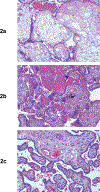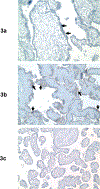A role of the anti-angiogenic factor sVEGFR-1 in the 'mirror syndrome' (Ballantyne's syndrome)
- PMID: 17118734
- PMCID: PMC6941849
- DOI: 10.1080/14767050600922677
A role of the anti-angiogenic factor sVEGFR-1 in the 'mirror syndrome' (Ballantyne's syndrome)
Abstract
Background: 'Mirror syndrome' (Ballantyne's syndrome) refers to the association of fetal hydrops with placentomegaly and severe maternal edema. Preeclampsia occurs in approximately 50% of these cases. Soluble vascular endothelial growth factor receptor-1 (sVEGFR-1), an anti-angiogenic factor, has been implicated in the pathophysiology of preeclampsia (PE).
Objective: The objective of this study was to determine if the maternal plasma concentration of sVEGFR-1 is elevated in patients with mirror syndrome.
Study design: This case-control study included patients with uncomplicated pregnancies (n = 40) and those with mirror syndrome (n = 4) matched for gestational age. Mirror syndrome was defined as fetal hydrops and severe maternal edema. Maternal plasma sVEGFR-1 concentrations were determined using specific enzyme-linked immunosorbent assays. Immunohistochemistry of sVEGFR-1 on villous trophoblasts was also performed in samples from one patient with mirror syndrome and compared with those from a patient with spontaneous preterm delivery matched for gestational age. Non-parametric statistics were used for analysis (p < 0.05).
Results: (1) The median maternal plasma concentration of sVEGFR-1 was significantly higher in patients with mirror syndrome than in the control group (median: 3974 pg/mL, range: 3083-10 780 vs. median: 824 pg/mL, range: 260-4712, respectively; p < 0.001). (2) All patients with mirror syndrome had sVEGFR-1 concentrations above the 95th percentile for gestational age. Syncytiotrophoblast, especially syncytial knots, showed strong staining with antibodies against sVEGFR-1 in placental samples from the patient with mirror syndrome, but not in those from the patient with spontaneous preterm delivery.
Conclusion: High maternal plasma concentrations of sVEGFR-1 were observed in mirror syndrome. We propose that this anti-angiogenic factor may participate in the pathophysiology of this syndrome. Thus, maternal plasma determination of sVEGFR-1 may help to identify the hydropic fetus that places the mother at risk for preeclampsia.
Figures



References
-
- Kaiser IH. Ballantyne and triple edema. Am J Obstet Gynecol 1971; 110: 115–120. - PubMed
-
- O’DRISCOLL DT. A fluid retention syndrome associated with severe iso-immunization to the rhesus factor. J Obstet Gynaecol Br Emp 1956; 63: 372–374. - PubMed
-
- COHEN A Maternal syndrome in Rh iso-immunization: report of a case. J Obstet Gynaecol Br Emp 1960; 67: 325–327. - PubMed
-
- Goodlin RC. Impending Fetal Death in Utero Due to Isoimmunization. Obstet Gynecol 1957; 10: 299–302.
-
- HIRSCH MR, MARK MS. Pseudotoxemia and Erythroblastosis. Report of a Case. Obstet Gynecol 1964; 24: 47–48. - PubMed
Publication types
MeSH terms
Substances
Grants and funding
LinkOut - more resources
Full Text Sources
Other Literature Sources
Medical
